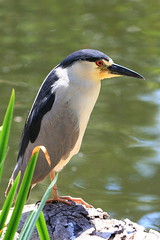I want to tell the story of Nellie the Night Heron. Night Herons are nocturnal birds, active evening, night, and early morning, and seldom seen during the day when they rest in trees.
In 2005, in Shell Beach, California (part of Pismo Beach), there were five nesting trees, and several trees occupied by fledglings after they have left the nest and start to fend for themselves. From trees near the bluffs overlooking the ocean, they can survey the tidepools and look for food. It was a difficult year for the fledglings due to unusually high waves and tides, and they had a hard time finding food on the reefs where they normally feed on small tidepool creatures at low tide. At high tide they feed along the high bluffs for rodents, bugs, and frogs, but development along the bluffs has shrunk their feeding places considerably.
I
These difficulties resulted in the eventual death of all of the 15 fledglings that left the rookery on Morro Street that year, except Nellie.
In November, 2005, a resident of Shell Beach, Terry Lilley, a biologist, and his research partner and neighbor, Sue Sloan, observed one of the still remaining night heron fledglings feeding on snails and worms in a neighbor's yard. This was unusual behavior for a night heron, and none of the other fledglings dared to do it, but would watch from nearby rooftops. For a month they watched this behavior, and finally realized the little heron was starving, so they decided to supplement its diet to help keep it alive. They bought night crawlers and threw some out to her every morning as they went on their usual walk with coffee to the beach. They named the heron "Nellie".
After a few weeks of morning feedings, they graduated from night crawlers to fish. They gave her one each morning, and she ate it with gusto. They made it a practice to feed her only a small amount in order not to interfere with her normal feeding.
Ever since first meeting Nellie three years ago, Terry and Sue have seen her almost every day. Although still a wild bird, she has become their friend in the sense that she interacts freely, and comes very close, sometimes even sitting on them. But she is still living a normal bird life, and in the spring of 2007, had her own three chicks. Interestingly, the chicks don't come close, even when their mother is sitting on a human lap getting a treat. This year, she is again showing her mating colors, and, chances are, will be a mother again in 2008.
Nellie was the only fledgling night heron to come down on the ground, the only one to eat worms, and the only one to survive.
In the summer of 2006, Andrews Real Estate hired Bunyon Brothers Tree Trimmers to cut down a mature healthy Monterey Pine at the end of Morro Street, the tree used by Nellie and other herons as their nesting and resting place during the day. Both were informed about the nests and the importance of the tree for all the resident herons, and that taking it down would be a violation of the federal Migratory Bird Act. A film crew came and filmed the realtor promising he wouldn't take down the tree, and aired it on KSBY TV News. In spite of his promise, the realtor had the tree trimming company go ahead, and the tree no longer exists. Nellie and all the other herons were dispossessed.
Shortly after this, Forister Tree Service cut ten long-term night heron nests out of another tree on Morro Street. Such colony nests are also protected under the Migratory Bird Act even if there are no eggs in them, but that was not enough to stop the destruction. The breeding night herons had to leave the tree when the trimmers showed up, and fled down the street to one of the last remaining trees with heron nests. The tree was on city property, but the home owner living near it squirted the herons and some of the nests out of the tree.
(To be continued.)
